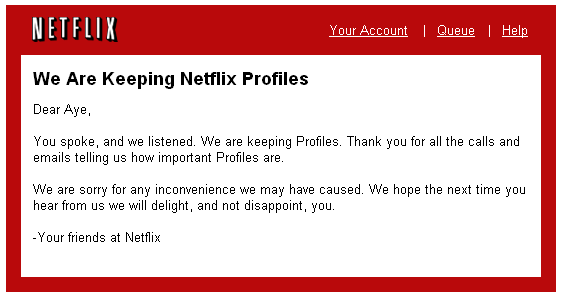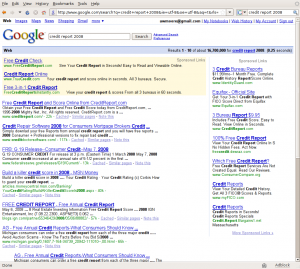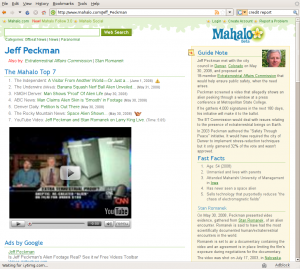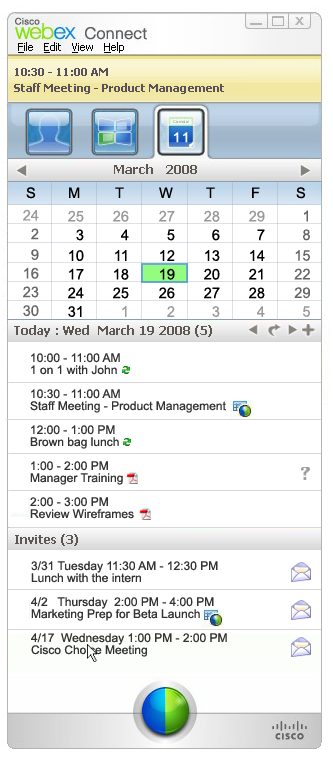Dignity, Grace and Courage
I heard Randy Pusch passed away on July 25th. The first time I heard about him/his lecture was several months ago and his video was still on Google Video site. It’s now on Youtube. Make sure you watch it if you haven’t seen it already.
He gave this speech at CMU 2008 Graduation a few months ago.
I have been thinking about the way he went through the last few months of his life. He has the dignity to accept the fate with grace instead of asking ‘why me? why now?’. And he had the courage to tell people what he’s dealing with. It takes incredible amount of courage to rise above wallowing in self pity and to make the best of the time you have left. As the joker in The Dark Knight said ‘you find out who a person is when he’s about to die’ (I am loosely paraphrasing here).
Since I have watched the first video, there is a phrase from the video that I have already incorporated into my life over this past year. Whenever I or someone near me is upset about any material thing, I remind myself and them “It’s a thing, not a person” . So his speech changed the way I see ‘things’ (I believe that will stay with me forever.) Random note: it’s awesome that he taught HCI at CMU.
To be honest, all this is coming out from me not just because Randy Paush passed away a few weeks ago. It’s also because it’s August and August makes me think of my late brother who passed away in August 99. He also had the dignity and grace to prepare for his last moments with us without panic, anger or self pity. He, too, kept working on his dreams and things he cared about up until the last minute. He didn’t give up and stopped trying even though he knew how little time he had.
He finished his advanced certificate for computer science while he was getting chemo in the hospital. His team project was basically implemented in his hospital room. (His team mates were the best people who obliged him and didn’t tell him that they couldn’t do the project with him cause he was in the hospital.) The weekend before he passed away, he was trying to convince the doctors and my parents to let him be part of his university’s rowing team for the next race since he’d been doing better for a while.
I am going to end this post with the link to Jamie Livingston who took a Polaroid a day for 18 years. The pictures from last month showed that he married his wife right before he died and that he was surrounded by his friends in his last days. He’s another person who kept on living up until the last minute.
this is the Polaroid he took on the day I was born.
Things don’t matter. People do.
Netflix listens.
About 2 weeks ago, Netflix announced they were getting rid of user profiles. They said the reason was to make the site more simple to use for everyone and they observed :
Too many members found the feature difficult to understand and cumbersome
I had my account set up with 2 profiles for a while so that the boyfriend can have his own queue. But we eventually got rid of the 2 profiles and just let him move the movies up and down my queue. I think the reason they said was probably true. The feature was not very usable. But I don’t think you could get rid of a feature many users are actively using just because some users found it difficult to understand. There must be something that Netflix wasn’t being honest about. If it was really the difficulty to use, shouldn’t it be the responsibility of the service to make the feature more usable, more understandable, less cumbersome? Getting rid of a feature people find it hard to use can’t be the right way to go about!
So people complained loudly and Netflix listened and they are keeping the feature. Here is the email I got just now.
Now, I believe it’s on the shoulders of the designers at Netflix to figure out how to make this feature not so hard to use.
06.1.08Introducing LagoMorph : New author
Since I’ve been completely crushed under the stress of getting my spec done for the last two weeks, I haven’t been able to post anything new lately. And opportunity presented itself for me to make sure my fledging blog not die from lack of updated content.
I got into a very long discussion/argument with LagoMorph on our ride down to Rangoli, our favorite Indian restaurant in Boston. And I got tired of telling him ‘Google is all about money. Nobody is going to get rid of their sponsor search results if that’s how their stock is worth over 500 a piece.’Â So I told him to go write his argument as a post to my blog as a contributing author.
Hope you enjoy it. He will be contributing every now and then.
Call-Your-Kids Search
CreditReport.com screwed my mom over last week – and Google helped them do it.
If you missed the singing dude in the pirate costume, FreeCreditReport.com (and CreditReport.com) make their money by giving you your credit report for free, then signing you up for expensive credit monitoring programs that nobody wants. Why would anyone fork over their money when credit reports are available for free without the scam credit monitoring programs thanks to the U.S. Government? It’s because people get confused, believe these sites are the official credit report site, don’t read the fine print, and hand over their credit card numbers because they think that’s part of the credit report identification process. These sites can only get money if they maintain the deception that they are the official free credit report site. If one of their visitors finds AnnualCreditReport.com, the jig is up.
How do these nefarious sites manage to trick people in the age of Google? Well, it’s pretty easy. My mom searched for “Credit Report 2008” with Google, and the picture below is what she got.
See any sign of AnnualCreditReport.com – practically the only site anyone searching for anything having to do with credit reports would want? Me neither. If you search for just “credit report” Google’s algorithms nail it, although it’s still hard to see underneath all the sponsored link clutter. The extra “2008” term kills PageRank, letting the search engine optimizers hijack the search results. CreditReport.com, here we come.
This set of results screams out for somebody to build better credit report search results page than Google’s algorithms. For this particular search, it’s not rocket science. 90% of the time, people searching for “credit report almost anything” want either their free annual credit report or a description of what a credit report is. Approximately 0% of the time, they want to sign up for crappy overpriced credit monitoring. Human-powered search seems like it could be the answer.
Unfortunately, we’re not there yet. Here’s what Mahalo (the only human-powered search engine I’ve heard of) displays for a search of “credit report.”
Wow, could that be less useful?
OK, they’re working on it, and they don’t have pages for everything yet. Fine. The problem is that the pages they do have won’t help my mom. The Guide Note is nice, but Wikipedia handles that, and my Mom already uses it. More importantly, where are the search results? Surely there are more than 7. Those 7, though, are all you’re getting from Mahalo.
Mahalo’s got exactly the right idea and exactly the wrong idea at the same time. My mom would love a site that uses humans to generate the top results for common searches like this one and outsources the rest of the results and the results for topics it doesn’t cover yet, behind the scenes, to someone like Google. I would love to install it as her home page. But she’s not going to want to watch Mahalo’s compulsory YouTube video or share the page on Facebook. She’s also not going to know what to do when Mahalo returns a Wiki-stub with a spam link or two as search results for something. Mahalo dedicates most of their page space to non-search stuff (scroll down for Web 2.0 overload) and puts stuff like Facebook, StumbleUpon, and Propeller on every page — and I don’t know a single person who knows what Propeller is.
Why is Mahalo targeting young, first-adopter, super-wired people instead of people like my mom? When we’re searching, all the Web 2.0 goodies in the world won’t intrigue us – we want good results fast. And in terms of good results fast, their editors are never going to be able to put together a page that will be able to beat Google for me. I’ve been searching the Internet for 12 years, and I’m as good or better than anyone they can afford to hire to write guide pages for them. Anyone who’s heard of Propeller is probably even better. The people who need human-powered help aren’t people like me, they’re people like my mom.
If Mahalo could get their name out as the site where you send your parents when they want to get a copy of their credit report without getting hit with $75 of nearly-fraudulent charges, they would get dozens and dozens of older eyeballs.
My mom likes to buy crap, and has a reasonable amount of disposable income. If you show her an ad for a porcelain unicorn (something that has 0% chance of confusing her when she’s searching for her credit report, but something she’s searched for before), she just might buy it. And there are a LOT of people over 45 with disposable income who get confused by Google’s search results.
Most of these people don’t understand that all that small print at creditreport.com means “these guys are going to charge me every month if I take them up on the ‘free credit report’ offer.” And a lot of them might throw in a “2008” at the end of their searches. I don’t think PageRank is going to be able to stay ahead of the search engine optimization people in cases like these.
Mahalo can. They need to be targeting people like my mom.
Right now, Google won’t pay the price for raking in their share of the spoils creditreport.com got from screwing over my mom. My mom is in the demographic of people who blame themselves whenever something goes wrong and a computer is involved. She won’t blame Google (like I do), and nobody else is any better anyway. cRANKy, the search engine targeting people over 50, is way too terrible to recommend.
For now, my mom will fight with CreditReport.com’s customer service, then initiate a chargeback with her credit card company. Next time she needs something like this, she will call me and feel ashamed that she can’t handle something that sounds so simple on her own. And until someone makes a better search for older people, call-your-kids search will be the answer. Just like it was in 1998.
05.14.08Some changes
Recent Changes
That rotating image widget on the right column is gone. I moved all my pictures to Pictures page. I got the javascript lightbox effect working on that page. All my venting/commenting on Burma’s current affairs now goes to Burma page. I put up the RSS widget to Word Spy. I just thought it’s interesting to find out about things like allergy bullying.
Future Plan
I will do something along the lines of a Portfolio page with password protection but I need to get permission from my manager first.
Algorithm to generate tag clouds
I was talking to a friend who’s trying to figure out a formula for generating tag cloud. The purpose of a tag cloud is to convey the extent of relevance of a tag among all other tags being used. Trying to display the frequency of tags sounds easy but there are different issues for different algorithms out there. ( the ones found by quick google search)
The first one is from WordPress Codex. The summary for the algorithm is they sort the tags by frequencies and then group them into each font size. The problem with this algorithm is if the max frequency is 5000 and the second to max frequency is 50. They will be displayed in the same font size since the algorithm does not take the frequency range into account. Also when frequency range is too narrow, a tag with 24 occurrences and a tag with 25 occurrences may just have different font sizes if the cut off happens to be between 24 and 25.
The second algorithm we found is this one. This one takes the frequency range into account but it tries to display tags in font sizes that only differ by 1 unit each. The problem here is human eye’s inability to detect varying font sizes if there are too many steps between the max font and the min font. So 100 different tags with sizes ranging from 10px to 48 px will not be visually distinguishable.
I figure if we take the second algorithm and modify it so that font size gap is big enough to be visible, it may just work.
count the frequencies for all tags
find min freq and max freq
x =Â freq of tag we want to calculate the font size
scaling factor, K = (x – min freq) / (max freq – min freq)
font range = max font size – min font size
font step = CÂ (the constant font step size)
font for tag =   min font size + (C * floor (K * (font range/ C)))
so if we reuse the example from the second algorithm
min freq = 6 , max freq = 91, freq for current tag = x
scaling factor K = (x – 6)/85
min font = 10 , max font = 30, font step = 4
font for tag = 10 + ( 4 * floor (( (x-6)/85) *( 20/4)))
so if x = 64, font for tag = 22
if x = 79, font for tag =Â 26
if x = 14, font for tag = 10
if x = 32, font for tag =14
Although it does not solve the problem of the max frequency so far off from the rest, it will pile more tags with lower frequencies into smaller font sizes. But a spike can be handled as a special edge case. this will work for most cases as long as the distribution curve is not too far off from the bell curve.
I need to look into another algorithm that takes median or mean with standard deviation as a way to generate banding. But it again won’t work since we are still assuming the distribution curve to be bell shaped.
I need to keep thinking about how we can display tag clouds with frequencies with a distribution curve that doesn’t fit bell shaped. It’d be nice to get real data of tag occurrences from live sources like flickr, youtube, digg etc.
05.5.08Cyclone damage in Burma

As you may have already heard, the damage is far more extensive than they originally estimated. 10,000 is quite far off from 350. I still haven’t got contact with my brother – which worries me but I think he should be okay.
For now, if you want to help, please donate to ICRC and designate it to Myanmar on the drop down list.
I look up a way to send money as soon as I saw the 10,000 number and realized ‘oh crap. this is really bad. I must do something.’ As far as I know, this is the most direct route to get food/water/medicine to the people who are affected since ICRC is already there and helping out. If you know of a more effective way to help, please let me know.
Edit: the number is climbing as more info is available. sigh. 🙁
I put up the pictures I took when I went home last time on the picture slide show widget on the right to remind everyone of what a beautiful country it is.
05.4.08Trulia Hindsight : Time lapsed map of residential development
Trulia has this tool called Hindsight that lets you enter an address and watch how that area develops over time since 1800s. http://hindsight.trulia.com/map/#lat=42.464&lon=-71.074&zoom=14&mix=0.500
Things I like about the time line control
1. They match the time on the time line with the dots on the map by color.
2. You can pause, resume and fast forward
3. You can limit the duration of the time line by dragging the boundaries
Things I would change
1. I wish they won’t make it play in a loop by default. I just want it to play it once and stop at the end of the first pass. So I actually have time to analyze what I am seeing.
2. Since they have the data for each node on the map, why can’t I hover/click on each node to get more details?
3. Color choices don’t really work for me. They seem too blended in and there is no culturally associated meaning of going from green to purple.
Google Finance also has a similar draggable boundary time line control. But it’s not a time lapsed display of events.
04.4.08WebEx Connect Client
WebEx Connect is a collaboration platform centered around web meeting. Designed meeting scheduling features for both desktop and web clients.








